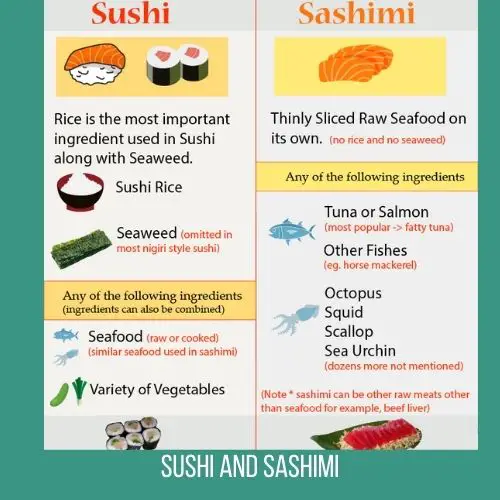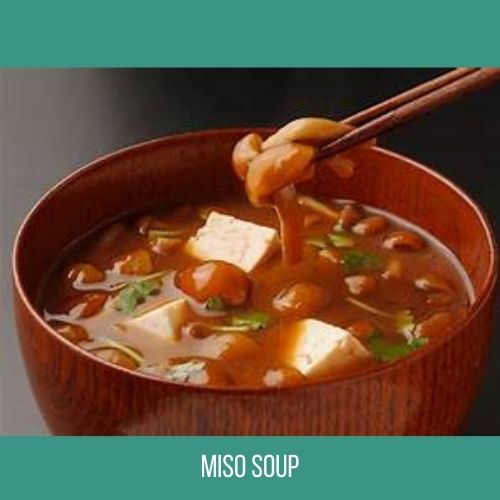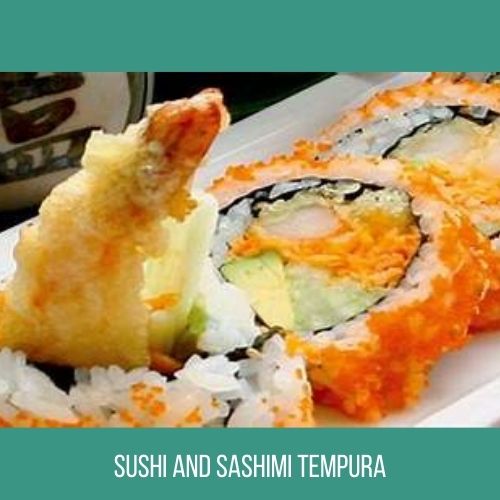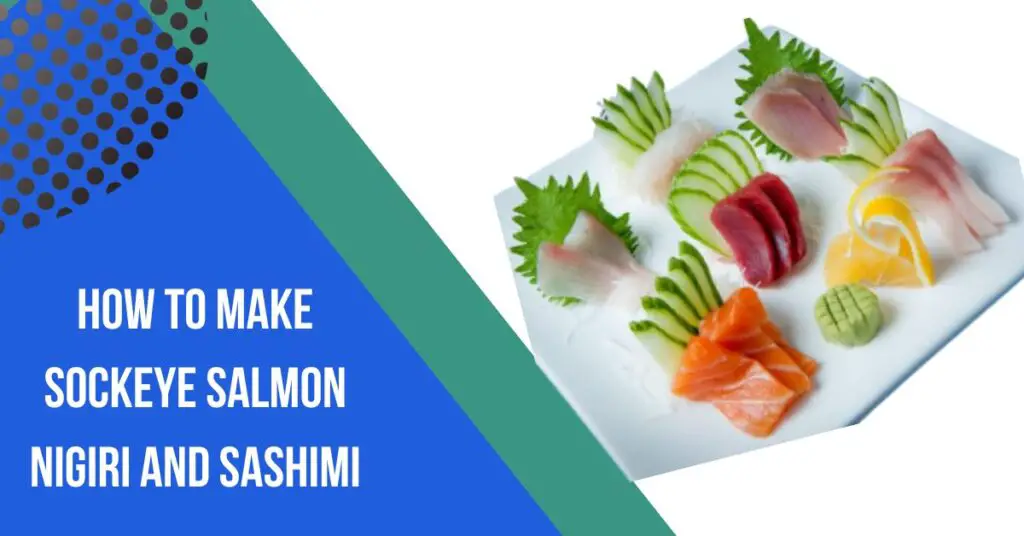Contents
- 1 How To Make Sockeye Salmon Nigiri And Sashimi:
- 2 Fresh Sockeye Salmon:
- 3 Wasabi And Soy Sauce:
- 4 Preparation of Sushi Rice:
- 5 Molding into bite-sized pieces:
- 6 FAQs:
- 7 1. Can I use any type of salmon for sushi?
- 8 2. Where can I buy sushi-grade Sockeye Salmon?
- 9 3. How do I store Sockeye Salmon for sushi at home?
- 10 4. Can I substitute regular rice vinegar for sushi vinegar?
- 11 5. Is it necessary to use a bamboo sushi mat for rolling sushi?
- 12 6. How do I prevent the rice from sticking to my hands when molding nigiri?
- 13 7. Can I make sushi rice in advance?
- 14 8. Are there alternatives to wasabi for sushi?
- 15 9. How long can I keep leftover sushi?
- 16 10. Can I make sushi with cooked salmon?
Welcome to the world of exquisite Japanese cuisine! Crafting perfect Sockeye Salmon Nigiri and Sashimi requires precision and respect for the ingredients.
In this brief guide, we’ll walk you through the art of preparing these delectable bites, ensuring a harmonious balance of flavors and textures to elevate your sushi experience.
Get ready to embark on a culinary journey as we unravel the secrets to creating stunning Sockeye Salmon Nigiri and Sashimi.
How To Make Sockeye Salmon Nigiri And Sashimi:
Japanese cuisine is renowned for its meticulous preparation, fresh and high-quality ingredients, and respect for seasonality. Here’s a brief overview:
>> Rice and Seafood Dominance:
>> Rice: A staple food in Japan, often served with every meal.
>> Seafood: Due to its island geography, Japan is abundant in fresh seafood, influencing many dishes.
>> Sushi and Sashimi:
>> Sushi: Vinegared rice combined with various ingredients, including raw or cooked seafood.
>> Sashimi: Sliced raw fish, often served without rice, highlighting the purity of the fish.

>> Miso Soup: A traditional Japanese soup made with fermented soybean paste, seaweed, and other ingredients like tofu and green onions.

>> Noodles: Ramen: Chinese-style wheat noodles served in a meat- or fish-based broth.
>> Soba and Udon: Buckwheat and wheat noodles served in hot or cold broths.

>> Tempura: Lightly battered and -fried seafood or vegetables, offering a delicate and crispy texture.

>> Tea Culture: Matcha: Finely ground green tea leaves, often used in traditional tea ceremonies.
>> Sake: Japanese rice wine, a significant part of Japanese drinking culture.
>> Kaiseki Cuisine: Multi-course meals emphasizing seasonality, presentation, and a variety of cooking techniques.
>> Izakaya: Japanese pubs offer a casual atmosphere and a wide range of small, shareable dishes.
>> Pickles and Fermented Foods: Pickled vegetables, such as tsukemono, and fermented soybean products like miso and soy sauce.
>> Seasonal Ingredients: Japanese cuisine strongly emphasizes using ingredients that are in season, resulting in fresh and flavorful dishes.
>> Artistic Presentation: Attention to detail in food presentation is an integral part of Japanese culinary culture, reflecting aesthetic principles. Japanese cuisine is a harmonious blend of tradition and innovation, providing a rich culinary experience that goes beyond taste, engaging all the senses.
Fresh Sockeye Salmon:
Fresh Sockeye Salmon is a popular and prized seafood known for its vibrant color, firm texture, and rich flavor. Here are some key characteristics and information about fresh Sockeye Salmon:

- Color:
Sockeye Salmon is easily recognizable by its red or orange-red flesh, which is a result of its diet of krill and shrimp. - Texture:
The flesh of fresh Sockeye Salmon is firm and succulent, with a moderately high-fat content that contributes to its rich mouthfeel. - Flavor:
Sockeye Salmon boasts a robust, full-bodied flavor with a hint of sweetness. The natural oils in the fish add to its overall taste profile. - Nutritional Value:
Rich in omega-3 fatty acids, Sockeye Salmon is a nutritious choice that supports heart health and provides essential nutrients like protein and vitamin D. - Wild-Caught:
Sockeye Salmon is often preferred in its wild-caught form, as it thrives in cold, pristine waters. This contributes to its high quality and purity. - Seasonality:
Sockeye Salmon has specific spawning seasons, and its availability can vary depending on the region. In North America, for example, the peak season is typically during the summer months. - Versatility:
It is a versatile fish that can be prepared in various ways, including grilling, baking, broiling, or even served raw as sushi or sashimi. - Sustainability:
Many fisheries implement sustainable practices to ensure the long-term health of Sockeye Salmon populations, considering factors like bycatch reduction and habitat preservation. - Culinary Applications:
Sockeye Salmon is well-suited for a range of dishes, from simple grilled fillets to more elaborate preparations in sushi, sashimi, or smoked salmon. - Freshness Indicators:
When choosing fresh Sockeye Salmon, look for clear and bright eyes, firm flesh, and a clean, ocean-like scent. Avoid any signs of discoloration or off-putting odors.
Sockeye Salmon’s exceptional taste and nutritional benefits make it a favorite among seafood enthusiasts, and its versatility in the kitchen allows for a wide array of culinary creations.
Wasabi And Soy Sauce:
Wasabi and soy sauce play integral roles in Japanese cuisine, particularly when enjoying dishes like sushi and sashimi. Wasabi, a pungent green paste, is derived from the roots of the Wasabia japonica plant. Known for its intense heat and distinct flavor, it adds a zesty kick to sushi, enhancing the overall dining experience.
Traditionally, a small amount of wasabi is placed between the rice and the fish in nigiri sushi, providing a burst of heat that complements the savory notes of the fish.
Soy sauce, on the other hand, is a savory and salty condiment made from fermented soybeans, wheat, salt, and water. Its umami-rich taste not only adds depth to dishes but also serves as a dipping sauce for sushi and sashimi.
When enjoying sushi, it is customary to dip the fish, not the rice, into soy sauce to avoid overpowering the delicate flavors. The combination of wasabi and soy sauce creates a harmonious balance, with the wasabi providing heat and the soy sauce contributing saltiness, resulting in a flavor profile that elevates the freshness of the seafood. Together, these condiments enhance the enjoyment of sushi, turning each bite into a symphony of flavors.

Preparation of Sushi Rice:
The preparation of sushi rice is a crucial step in creating authentic and delicious sushi. Here’s a step-by-step guide to achieving the perfect sushi rice:
- Ingredients:
Sushi Rice (short-grain or medium-grain rice)
Rice
Vinegar
Sugar
Salt
- Washing the Rice:|
Rinse the sushi rice under cold water until the water runs clear. This helps remove excess starch that can make the rice too sticky.
- Soaking the Rice:
Allow the washed rice to soak in water for about 30 minutes. This helps the grains absorb moisture evenly during cooking.
- Cooking the Rice:
Cook the soaked rice in a rice cooker or on the stovetop according to the package instructions. Use slightly less water than usual to achieve a firmer texture.
- Preparing the Sushi Vinegar:
In a small saucepan, combine rice vinegar, sugar, and salt. Heat the mixture over low heat until the sugar and salt dissolve. Allow it to cool.
- Seasoning the Rice:
Once the rice is cooked, transfer it to a large, flat dish or hangiri (wooden sushi rice mixing bowl). While the rice is still hot, gently fold in the sushi vinegar mixture using a wooden spatula or rice paddle.
- Fanning the Rice:
As you mix in the vinegar, use a fan or a cool breeze to help cool the rice rapidly. This step is essential for achieving the right texture and glossy finish.
- Consistency Check:
Ensure that the rice is evenly seasoned and has a glossy appearance. Each grain should be separate yet sticky enough to hold together when pressed.
- Covering the Rice:
Cover the sushi rice with a damp cloth to prevent it from drying out while you prepare the other components of your sushi.
- Ready for Use:
Your perfectly seasoned sushi rice is now ready to be used for making various types of sushi, including nigiri, sashimi, and rolls.
Remember, the art of sushi rice is fundamental to creating exceptional sushi. The balance of sweetness, acidity, and saltiness in the seasoned rice enhances the overall taste of your sushi creations.
Molding into bite-sized pieces:
After meticulously preparing the sushi rice, the next step in crafting delectable Sockeye Salmon Nigiri involves molding the rice into bite-sized pieces. This process requires finesse to achieve the perfect balance between the rice’s texture and the succulent Sockeye Salmon topping. Here’s how you can master the art of molding nigiri:
- Dampen Your Hands:
Keep a bowl of water nearby to moisten your hands lightly. This prevents the rice from sticking to your fingers, ensuring a smooth and even surface.
- Portion Control:
Take a small amount of sushi rice, typically about a tablespoon, and gently squeeze it between your hands to form an oval or rectangular shape. The rice should be compact enough to hold together but not overly dense.
- Create a Base:
Press the rice into a small, oblong shape, creating a slightly raised platform for the Sockeye Salmon to rest on. Ensure the rice is centered for a balanced bite.
- Add Wasabi:
- Optionally, add a small amount of wasabi to the rice before placing the Sockeye Salmon on top. The heat from the wasabi enhances the overall flavor experience.
- Place the Sockeye Salmon:
- Take a slice of fresh Sockeye Salmon and gently lay it over the formed rice base. The goal is to showcase the fish’s color and texture while allowing the rice to complement and support it.
- Shape and Press:
With your fingers, delicately shape and press the Sockeye Salmon onto the rice, ensuring a secure and elegant union. The rice should lightly adhere to the fish, maintaining the distinct layers of flavor and texture.
- Uniformity is Key:
Strive for consistency in size and shape among your nigiri pieces. This not only enhances the visual appeal but also ensures a consistent eating experience for those savoring your culinary creations.
- Repeat the Process:
Continue molding the sushi rice and adding Sockeye Salmon slices until you’ve crafted the desired number of nigiri pieces for your presentation.
Molding nigiri is both an art and a skill that develops with practice. The attention to detail in creating uniform, bite-sized masterpieces is a testament to the precision and craftsmanship inherent in Japanese culinary traditions. With each molded piece, you’re one step closer to a visually stunning and palate-pleasing Sockeye Salmon Nigiri experience.
Conclusion:
In conclusion, the art of crafting Sockeye Salmon Nigiri and Sashimi is a journey that blends precision, fresh ingredients, and a respect for Japanese culinary traditions. From the meticulous preparation of sushi rice to the delicate molding of bite-sized nigiri pieces, every step contributes to the creation of a culinary masterpiece.
The harmonious combination of vibrant Sockeye Salmon, perfectly seasoned rice, and the subtle heat of wasabi and soy sauce results in a sensory delight that captivates both the eyes and the palate.
Whether you’re a sushi enthusiast or a novice in the kitchen, these techniques open the door to a world of flavors that celebrate the essence of Japanese cuisine.
This culinary adventure, experiment with creativity, and savor the beauty of homemade Sockeye Salmon Nigiri and Sashimi.
FAQs:
1. Can I use any type of salmon for sushi?
While various types of salmon can be used, Sockeye Salmon is popular for its vibrant color and rich flavor. Ensure the salmon you choose is labeled as sushi-grade or suitable for raw consumption.
2. Where can I buy sushi-grade Sockeye Salmon?
Look for reputable seafood markets, fishmongers, or grocery stores that explicitly label their fish as sushi-grade. It’s crucial to buy from trusted sources to ensure freshness and safety for raw consumption.
3. How do I store Sockeye Salmon for sushi at home?
Keep Sockeye Salmon refrigerated at temperatures below 40°F (4°C). If you’re not using it immediately, consider freezing it and thawing it in the refrigerator before use.
4. Can I substitute regular rice vinegar for sushi vinegar?
Sushi vinegar is a seasoned rice vinegar, but you can create a similar effect by adding a bit of sugar and salt to regular rice vinegar. Adjust the proportions to achieve the desired sweetness and saltiness.
5. Is it necessary to use a bamboo sushi mat for rolling sushi?
While a bamboo sushi mat makes rolling easier, you can improvise with plastic wrap or a kitchen towel. Ensure the surface is smooth to prevent rice from sticking.
6. How do I prevent the rice from sticking to my hands when molding nigiri?
Keep a bowl of water nearby and moisten your hands lightly before handling the rice. This helps prevent sticking and allows for smoother molding.
7. Can I make sushi rice in advance?
Sushi rice is best when fresh, but you can make it a few hours ahead. Keep it covered with a damp cloth to prevent drying, and gently reheat if needed.
8. Are there alternatives to wasabi for sushi?
If you don’t have wasabi, you can use a mixture of horseradish and mustard as a
substitute. However, wasabi adds a unique flavor, so it’s worth including if possible.
9. How long can I keep leftover sushi?
Sushi is best enjoyed fresh, but if you have leftovers, store them in the refrigerator and consume them within 24 hours. Keep in mind that the texture of the rice may change when refrigerated.
10. Can I make sushi with cooked salmon?
Absolutely! While traditional nigiri and sashimi feature raw fish, you can create delicious sushi with cooked or smoked salmon. Adjust the preparation accordingly for a delightful cooked variation.







